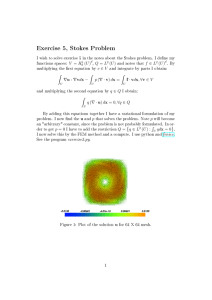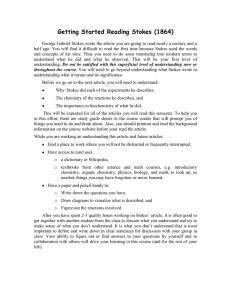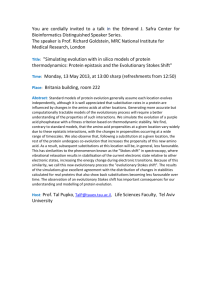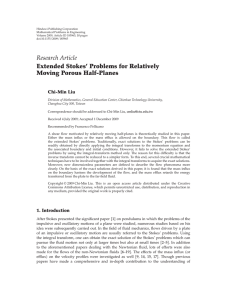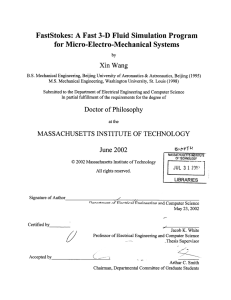Optical stokes flow: an imaging-based control approach Paul Ruhnau , Christoph Schnörr
advertisement
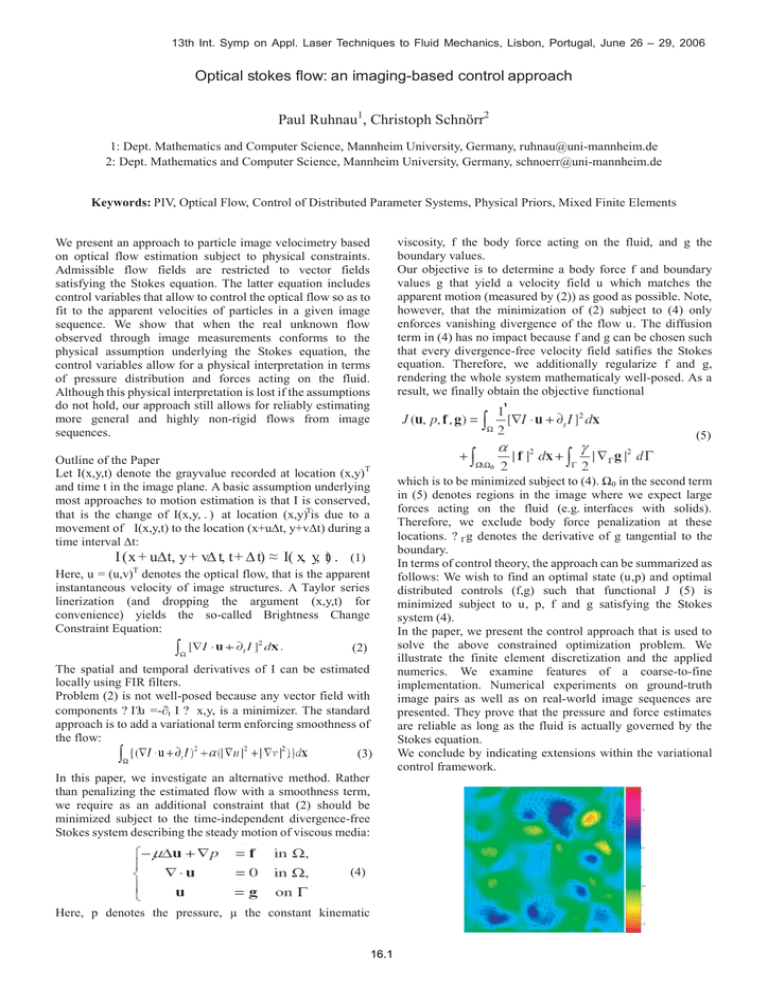
13th Int. Symp on Appl. Laser Techniques to Fluid Mechanics, Lisbon, Portugal, June 26 – 29, 2006 Optical stokes flow: an imaging-based control approach Paul Ruhnau1, Christoph Schnörr2 1: Dept. Mathematics and Computer Science, Mannheim University, Germany, ruhnau@uni-mannheim.de 2: Dept. Mathematics and Computer Science, Mannheim University, Germany, schnoerr@uni-mannheim.de Keywords: PIV, Optical Flow, Control of Distributed Parameter Systems, Physical Priors, Mixed Finite Elements We present an approach to particle image velocimetry based on optical flow estimation subject to physical constraints. Admissible flow fields are restricted to vector fields satisfying the Stokes equation. The latter equation includes control variables that allow to control the optical flow so as to fit to the apparent velocities of particles in a given image sequence. We show that when the real unknown flow observed through image measurements conforms to the physical assumption underlying the Stokes equation, the control variables allow for a physical interpretation in terms of pressure distribution and forces acting on the fluid. Although this physical interpretation is lost if the assumptions do not hold, our approach still allows for reliably estimating more general and highly non-rigid flows from image sequences. Outline of the Paper Let I(x,y,t) denote the grayvalue recorded at location (x,y)T and time t in the image plane. A basic assumption underlying most approaches to motion estimation is that I is conserved, that is the change of I(x,y, . ) at location (x,y)Tis due to a movement of I(x,y,t) to the location (x+u∆t, y+v∆t) during a time interval ∆t: I ( x + u∆ t, y + v∆ t, t + ∆ t) ≈ I( x, y, t) . (1) Here, u = (u,v)T denotes the optical flow, that is the apparent instantaneous velocity of image structures. A Taylor series linerization (and dropping the argument (x,y,t) for convenience) yields the so-called Brightness Change Constraint Equation: . (2) The spatial and temporal derivatives of I can be estimated locally using FIR filters. Problem (2) is not well-posed because any vector field with components ? I?u =-∂t I ? x,y, is a minimizer. The standard approach is to add a variational term enforcing smoothness of the flow: . (3) In this paper, we investigate an alternative method. Rather than penalizing the estimated flow with a smoothness term, we require as an additional constraint that (2) should be minimized subject to the time-independent divergence-free Stokes system describing the steady motion of viscous media: ? − μ∆u + ? p = f inΩ, ? = 0 in Ω, ? ?? u ? = g on Γ u ? (4) Here, p denotes the pressure, μ the constant kinematic 116.1 6.1 viscosity, f the body force acting on the fluid, and g the boundary values. Our objective is to determine a body force f and boundary values g that yield a velocity field u which matches the apparent motion (measured by (2)) as good as possible. Note, however, that the minimization of (2) subject to (4) only enforces vanishing divergence of the flow u. The diffusion term in (4) has no impact because f and g can be chosen such that every divergence-free velocity field satifies the Stokes equation. Therefore, we additionally regularize f and g, rendering the whole system mathematicaly well-posed. As a result, we finally obtain the objective functional J (u , p , f , g ) = ∫ Ω +∫ Ω\ Ω0 1 [? I? u + ∂ t I ]2 dx 2 α 2 | f | dx + ∫ 2 Γ γ 2 (5) 2 | ? Γ g| dΓ which is to be minimized subject to (4). Ω0 in the second term in (5) denotes regions in the image where we expect large forces acting on the fluid (e.g. interfaces with solids). Therefore, we exclude body force penalization at these locations. ? Γg denotes the derivative of g tangential to the boundary. In terms of control theory, the approach can be summarized as follows: We wish to find an optimal state (u,p) and optimal distributed controls (f,g) such that functional J (5) is minimized subject to u, p, f and g satisfying the Stokes system (4). In the paper, we present the control approach that is used to solve the above constrained optimization problem. We illustrate the finite element discretization and the applied numerics. We examine features of a coarse-to-fine implementation. Numerical experiments on ground-truth image pairs as well as on real-world image sequences are presented. They prove that the pressure and force estimates are reliable as long as the fluid is actually governed by the Stokes equation. We conclude by indicating extensions within the variational control framework.

